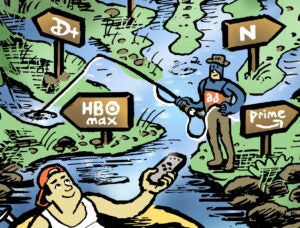 “On TV And Video” is a column exploring opportunities and challenges in programmatic TV and video.
“On TV And Video” is a column exploring opportunities and challenges in programmatic TV and video.
Today’s column is written by Bryan Noguchi, senior vice president and media director at R2C Group.
In the late 1990s, when the internet was still relatively new, the “content is king” mantra was an overwhelming omnipresence that eventually fell victim to audience targeting. It was the net result of an industry discovering that the content a user consumes isn’t the best or only way to triangulate where to find them.
But “content is king” is on the comeback trail as the media industry rediscovers the bottom-line fact that it can’t deliver the eyeballs if it fails to attract them in the first place. In a burgeoning on-demand world, the value exchange represented by content that is underwritten by advertising has become pretty muddled.
And consumers are increasingly insisting upon an a la carte curation of networks and programming, coupled with a somewhat reckless willingness to directly pay for it.
Late To The Party?
I saw that YouTube Red recently cut a deal to exclusively stream a 10-episode evolution of Channing Tatum’s “Step Up” movie, which made me realize how high the content stakes really are.
Imagine every streaming service as a video game platform: If Xbox didn’t have the breakout game “Halo,” it might have gone the way of Sega Saturn. Just as the networks need prime-time anchor shows, so too do HBO, Hulu, Netflix, YouTube and Amazon. Hence – respectively – “The Sopranos,” “The Path,” “House of Cards,” “Step Up” and “The Man In the High Castle.”
Original content drives subscribers – HBO proved this a long time ago. The volume of subscribers and the price they pay dictates how much original content a media entity can afford to produce, and the more an entity can produce – provided it is of high quality – the more subscribers it can attract. From there, it’s just a question of how it monetizes those subscribers.
Interestingly, from the short list above, only HBO and Netflix don’t really have a revenue channel based on advertising; between the two, Netflix strikes me as dangerously underdiversified. The other thing is that as long as a media entity can produce a genuine hit show, it technically can’t be too late to the party (Xbox, anyone?). So really, even Vimeo still has a chance to establish its relevance.
The Consequences Of Excess
I actually don’t buy the arguments around cord cutting and the “unbundling” of cable and satellite offerings. To me, it all reads like the comic book ads of the 1970s when it comes to the actual product: “Hmm, this is a pretty loose definition of ‘X-ray’,” or “Hey, this hand buzzer uses exactly ZERO electricity!”
I think you’re fooling yourself if you don’t view the entire Netflix library as a version of a content bundle – my subscription is partially underwriting the 99.99% of titles that I will never watch. So what am I paying for?
Well, the truth of the matter is that I pay for HBO to get “Game of Thrones” and “Silicon Valley,” with the “bundle bonus” being that I can watch “Hoosiers” and “The Shawshank Redemption” for the 1,000th time each, commercial free on Encore. We have Netflix primarily for “House of Cards” and “Orange is the New Black.” I think we never cancelled our Hulu trial because suddenly it got “The Mindy Project.”
The point here is that a lot of people are committing to subscriptions based on single programs, and if the five programs I cited above were on five different networks, there’s a good chance that I’d have five separate subscriptions instead of three. That adds up.
And since each of those subscriptions is effectively a continuity purchase, you can see where there’s a point at which your grandmother’s disturbingly perpetual supply of Shaklee products starts to look like savvy shopping compared to your bottomless appetite for streaming and on-demand media.
At some point, cord cutting ceases to be a sound decision based on economics, but is instead mostly a referendum on our tolerance for advertising.
A Thousand Wounds
Many media consumers will reach a tipping point where the cash outlay simply can’t justify the returns – at some point we’ll need to set aside funds to feed and clothe ourselves. As it is, the media companies already recognize that they can’t maintain a broadly appealing stable of programs if every show has to have the production value of “Game of Thrones.”
Equally apparent is consumers’ unwillingness to exchange their time and attention for low-quality programming. Clearly, a compromise needs to be struck – better, more engaging content for a little cash and fewer, less annoying ads. Hulu, YouTube and a handful of video on-demand platforms seem to be making progress toward this end.
As a media professional, I hate the idea of losing connection opportunities with audiences, but I don’t want to speak to them where and when I might be viewed as an intruder or a nuisance. In a world where content is king, bad content stands out, and if we lose sight of the fact that our ads and choices around where and how often they are seen are also content decisions, we stand to lose relevance.
If we lose relevance, we lose audiences, and if audiences go away, there’s generally less incentive and ability to create great content. At that point, fragmentation will seem like a quaint and enviable issue, because the challenge will instead be the brutal slog of winning audiences back, and nobody wants that.
If we can successfully reset and reinsert ourselves into the value exchange, I don’t see any reason for this not to be advertising’s golden age, where we proudly enable the content consumers want in a seamless, creative and mutually beneficial way.
Follow R2C Group (@r2cgroup) and AdExchanger (@adexchanger) on Twitter.













